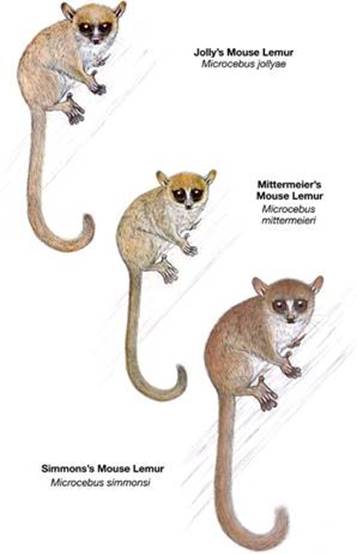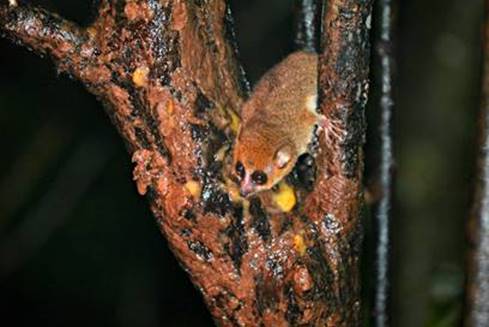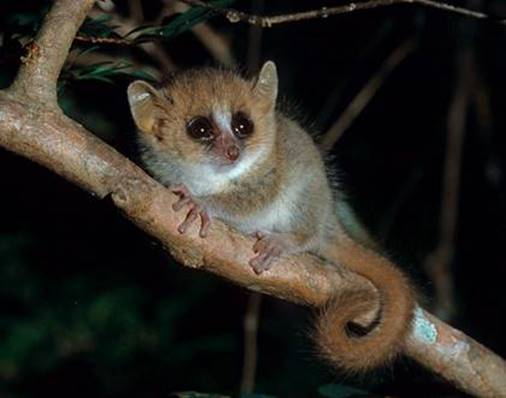The ears were large, flaring forward, the eyes limpid amber, in which the pupil floated like a glittering jewel, changing color with shifts of the light: obsidian, emerald, ruby, opal, amethyst, diamond. – William S. Burroughs, Ghost of Chance.
Lemurs are primates and only found on the island of Madagascar. They are found throughout the island in forest and some human-modified habitats such as scrubby secondary forests and sometimes in plantations. They are small, generally less than 11 inches long in total body length, weigh 1.4 – 1.7 ounces, and they are nocturnal. They are quite a diverse and specialized group – many parks in Madagascar have an endemic mouse lemur found nowhere else on the island. In 1996 scientists thought there were two mouse lemur species; today 20 species are recognized, but that is a cautious estimate. Microcebus – Greek micro – small, and cebus – monkey.

Individual species are hard to identify. Mouse lemurs are generally the same size and have a similar coloration – buffy brown on top, light underneath, and a body about the size of your fist. Thus, most of the taxonomy of the species depends on genetic studies. Their home range is correspondingly tiny – 0.01 – 0.02 mi2. The smallest mouse lemur species – Madame Berthe’s mouse lemur, weighs the equivalent of 13 pennies.
Mouse lemurs are opportunistic feeders – they will eat a wide variety of plant and animals including small vertebrates, arthropods, tree gum, fruit, flowers, nectar, leaves, and buds. Sweet secretions of insects and trees are thought to be important food items for some species.
Mouse lemurs exhibit two types of torpor – or periods of inactivity – daily and seasonal. These species are nocturnal, when they scurry around branches in search of food and then lay low in tree cavities for 9 hours at a time. Seasonal torpor allows lemurs to function in times of low food availability, which may last for several weeks. To make it more confusing not all mouse lemurs of a particular species and place may use this strategy. Some individuals will lay low for weeks to conserve energy while others do not. Body weigh increases with the more abundant resources associated with the raining season and body weigh decreases during the lean dry season.
Owls, raptors, tree boas, and mongooses are known predators. One ecologist noted a group of mouse lemurs mobbing a tree boa – harassing it and biting – to chase it away.
Trying to find a mouse lemur in the wild is, well, interesting. Finding one in its daytime cubby is next to impossible so you need to go out at night with headlamps and a strong flashlight. They scurry around so quickly that you often get just a fleeting glance. At Rannamafanna National Park the guides cheat a bit. They place some smears of banana on the same small tree on the side of the road so the tourists will get a glimpse at several somewhat stationary mouse lemurs as they visit for their regularly nightly scheduled snack.

One evening we were walking on a dirt road outside of the park looking for a variety of nocturnal lemurs with Ralahay, our guide. We managed to get a few brief glances of mouse lemurs among the shrubs along with a number of chameleons and woolly lemurs. Ralahy is often hired by researchers to help them find their lemur subjects. He said he worked a couple of years on mouse lemurs and it was quite difficult, crashing through the underbrush, trying to keep up with them. He said than many of the mouse lemurs will congregate in groups of six or so at the end of night at a staging area. He thought it was as if they were counting heads before going to their communal cavity to sleep during the day.
On the way back to the truck we were listening to the night sounds and the voices drifting to us from the nearby village when Ralahay stopped and pointed to the nearby shrubs. He turned on his light and there was a mouse lemur at eye level. We squatted down to watch him in the thicket, foraging on flowers. I thought he was gone when Connie found him again, this time about a foot off the ground and within arm’s reach. I didn’t bother to try and get a photo. Instead we were all silent and mesmerized as we watched this miniature primate cup its hands around a large flower and stuff his face into it to suck up the nectar. Later that night in bed, beneath the mosquito netting, that image lulled me to sleep.
